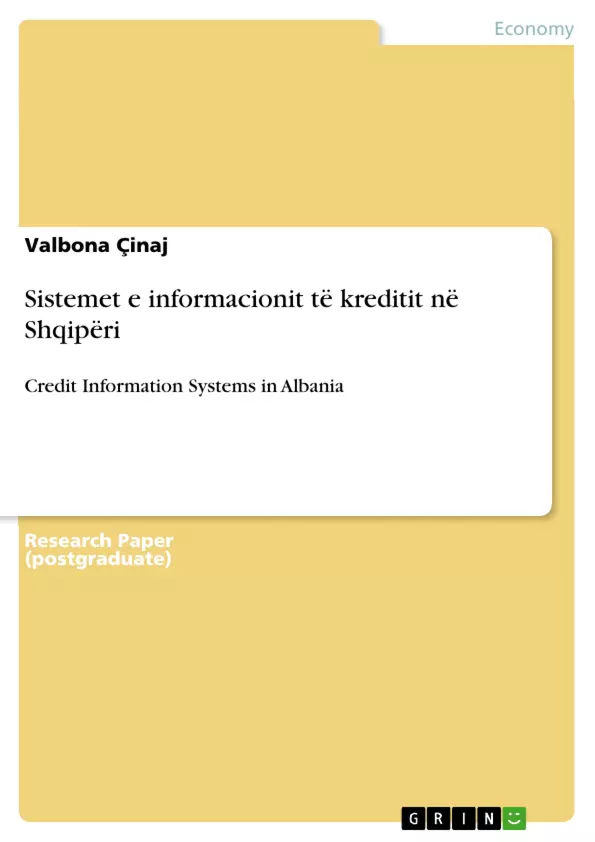Kudo në botën në zhvillim, rritja e disponueshmërisë së kredisë dhe konkurrenca e rritur mes huadhënësve kanë krijuar nevojën e shkëmbimit të informacionit të kredisë, sepse shtrirja dhe efikasiteti i mekanizmave të shkëmbimit të informacionit ndryshojnë shumë midis vendeve. Disa huadhënës në Shqipëri kanë ngjallur interes në mundësinë e krijimit të Sistemeve te Informacionit të Kreditit (SIK) për të ndihmuar në menaxhimin e rrezikut huamarrës.
Në mënyrë të ngjashme, shumë ekonomi janë dëshmitare për rritjen e madhe në mbulimin e informacionit të kreditit, duke përfshirë edhe ndërgjegjësimin në rritje të domosdoshmërisë së shkëmbimit të informacionit midis huadhënësve të shumtë.Sistemet e informacionit të kreditit SIK janë të përkushtuar për të ofruar të mira për raportimin e kreditit, menaxhimin e vlerësimit dhe zbutjen e rrezikut të kreditimit të produkteve.
Sistemi i informacionit të kreditit SIK mbledh informacion nga burime të ndryshme dhe jep informacion të kredisë konsumatore për konsumatorët për një shumëllojshmëri përdorimi. Informacione si ecuritë e mëparshme të kredisë së një personi janë një mjet i fuqishëm për të parashikuar sjelljen e tij të ardhshme. Institucione të tilla informacioni rreth kredive zvogëlojnë efektin e informacionit asimetrik midis huamarrësve dhe huadhënësve, për të lehtësuar problemet e përzgjedhjes së pafavorshme dhe rrezikut moral. Për shembull, informacioni i mjaftueshëm i kreditit mund të lehtësojë huadhënësit në shfaqjen dhe monitorimin e huamarrësit, duke shmangur dhënien e kredive për individët me rrezik të lartë.
Kjo ndihmon huadhënësit të vlerësojnë meritat e kreditit, aftësinë për të paguar përsëri një kredi, dhe ndikimin në normën e interesit dhe kushtet e tjera të kredisë. Normat e interesit nuk janë të njëjta për të gjithë, pasi bazohen në rrezikun e çmimeve, një formë e diskriminimit të çmimeve bazuar në rreziqet e ndryshme të pritshme të huamarrësve të ndryshem, siç është përcaktuar në vlerësimin e tyre të kreditit.Konsumatorët me një histori në mospagimet në kohë të kredisë apo detyrime borxhesh në tatime etj, do të gjykohen me një normë më të lartë interesi vjetor se konsumatorët të cilët nuk kanë këta faktorë.
Frequently asked questions
What is this document about?
This document provides a language preview including a title, table of contents, objectives and key themes, chapter summaries, and key words.
What are Credit Information Systems (CIS)?
CIS are systems used by lenders to address asymmetric information between borrowers and lenders, which can lead to adverse selection and moral hazard. They help mitigate non-repayment of loans and client overlap.
What is credit scoring?
Credit scoring is a technique used by credit providers to decide whether to grant credit to an applicant. It helps assess the risk of default.
Why is data mining relevant to credit scoring?
Data mining techniques are used in credit scoring models to extract explicit conditions for accepting/rejecting applicants. These techniques are considered more understandable by business people than other methods.
What are the challenges in lending practices, particularly in developing countries?
Lending is challenging due to weak legal/judicial enforcement, difficulty in obtaining information about borrowers' ability and willingness to repay, and the presence of many poor households/firms without prior borrowing experience or collateral.
What is the role of credit registries?
Credit registries are associated with increased lending volume, growth of consumer lending, improved access to financing, and a more stable banking sector.
What are the key themes discussed?
The key themes include Credit Information Systems, Credit scoring models, credit score evaluation, the credit risk, and Data Mining.
What are the benefits of credit scoring?
Credit scoring offers numerous benefits, including reducing discrimination, increasing the speed and consistency of credit application processing, lowering the cost of granting credit, determining appropriate interest rates, and helping manage risk more effectively.
What is Regjistri kredive and how does it function in Albania?
It is the Credit Registry of Albania. Banks and financial institutions can access borrower information but only after obtaining consent from the applicant. It is a public credit registry, meaning it is administrated by the government.
What is the difference between Rregjistri kredive and Credit Information Systems (SIK)?
SIK is a more comprehensive credit information system than a credit registry, including data from a wider range of sources, including non-banking institutions and public records. While Rregjistri kredive provides low cost credit, it tends to lack investment from outside and lacks detailed information.
What other data do credit institutions in Albania use to assess borrowers in the absence of a fully developed CIS?
Banks in Albania often rely on "relationship lending," which involves gathering information through continuous, personalized contact with individuals and businesses, as well as through contacts with the local community.
What is the role of the Credit Information Agency CIA?
The CIA or Credit Information Agency is the national credit registry system.
What is the future of credit scoring?
Credit scoring is going to be more innovative and will integrate technology, in order to be efficient.
- Citation du texte
- Valbona Çinaj (Auteur), 2016, Sistemet e informacionit të kreditit në Shqipëri, Munich, GRIN Verlag, https://www.grin.com/document/338224



